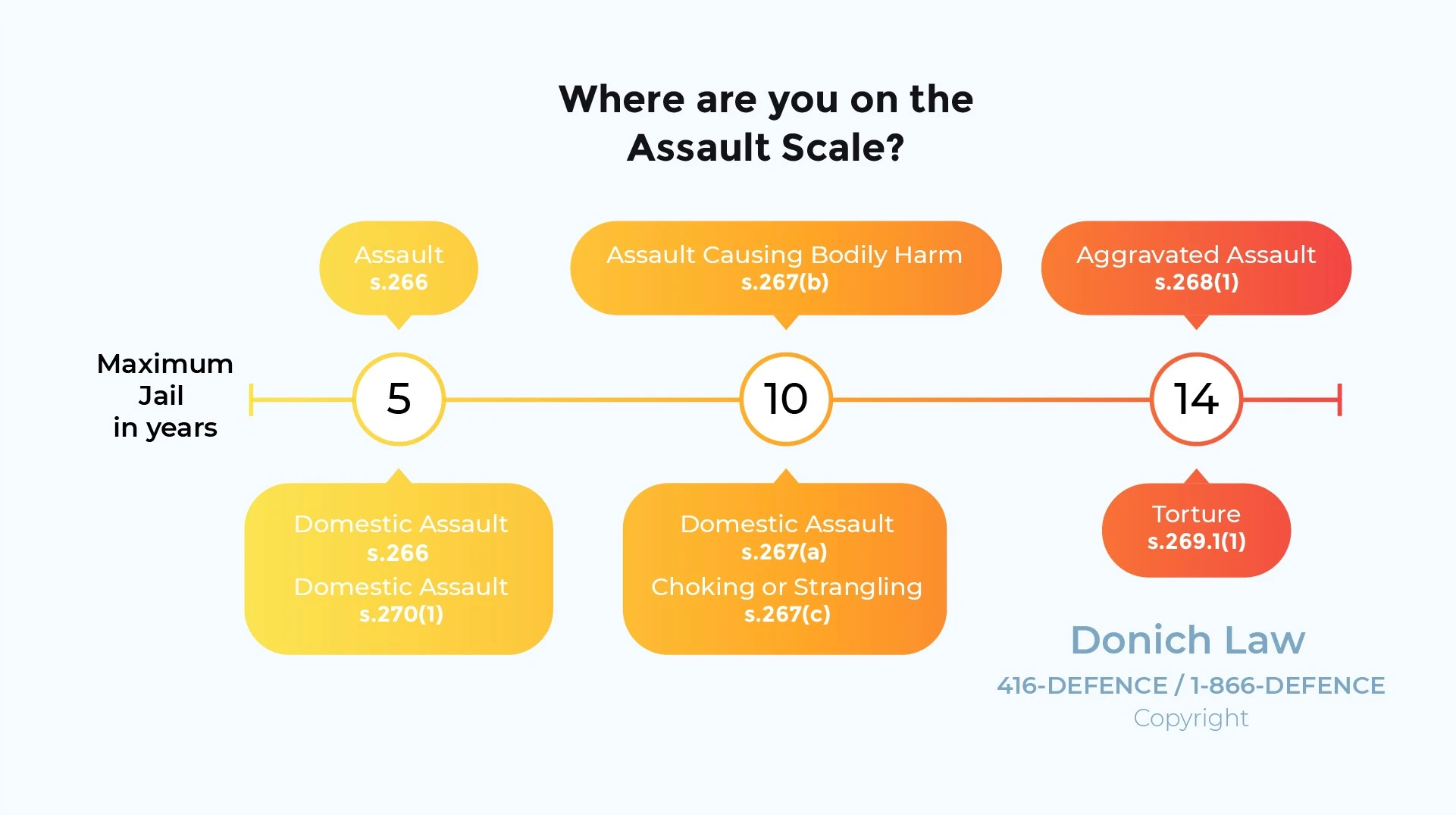
Defend Assault Charges
Our Experience
In 2021, the Firm represented an individual charged with false information, indecent communications and criminal harassment in R. v. B.K. [2021]. The accused was alleged to have sent private messages over Instagram, using a fake account, to a mutual friend of his ex-partner, indicating that she wished to engage in particular sexual acts. The mutual friend contacted the complainant and showed her the message, resulting in law enforcement using IP address information to track down the sender. The Firm negotiated the matter for over a year, ultimately resolving the case without a criminal record for the accused.
In R v. A.M. [2021], the Firm defended an individual charged with assault, assault causing bodily harm and choking after an alleged altercation with his same-sex domestic partner. After roughly nine months of negotiations, the Firm was able to resolve the matter without a criminal record by way of peace bond. This was accomplished through affidavit evidence. Choking charges are difficult to defend because of the violent nature of the offence. In many cases they will proceed to trial, but can be avoided where the complainant has independent legal counsel.
In 2021, the Firm successfully resolved a case for a client who was charged with assault and assault with a weapon in R. v. J.D. [2021]. The accused was alleged to have assaulted his domestic partner with a weapon during an argument. Once charges were laid, a no contact order was put in place prohibiting the accused from contacting the complainant. The complainant hired independent legal counsel to assist her in restoring contact. The complainant’s counsel and the Firm presented a united defence, ultimately leading to a withdrawal of the charges.
In R. v. B.W. [2021], the Firm defended a client charged with 2 counts of assault, assault with a weapon, uttering death threats and forcible confinement. During trial, the Firm exposed material inconsistencies in the complainant’s allegations and the client was found not guilty of 4 out of 5 charges and granted a discharge. Given the number of charges, the Crown was not willing to offer a favourable resolution position in advance. Once the accused testified and the complaint was found to be not credible, the defence was able to resolve the matter without a conviction.

- CP24: Civil Sexual Assault Lawsuit at St. Michael’s in Toronto.
- Global News Morning Show: Sentencing Arguments in Assault case of Dafonte Miller.
- Breakfast Television: Role of Mental Health in Court Proceedings.
- Global News National: Bruce McArthur will not serve consecutive sentences.
- CBC Radio: Interview with Mayor John Tory and Jordan Donich on CBC Radio.
- CTV News National: Handgun ban supported by majority of Canadians: Nanos survey.
- Global News: How difficult is it to get a legal handgun in Canada.
- CP24: Sentencing Hearing for Chair Girl.


In 2021, the Firm successfully represented an accused charged with simple assault after allegedly assaulting his domestic partner in R. v. A.R. [2021]. The complainant alleged that while intoxicated, the accused became angry and struck her in the face and pulled her hair during an argument. The complainant hired legal counsel of her own to help vary the no contact order put in place by the court. External legal counsel worked with the Firm to present a united defence, ultimately resulting the charges being withdrawn at the request of the Crown.
In the Firm’s R. v. P.C. [2020], it secured a withdrawal of assault on a permanent resident after allegedly pulling a kitchen knife on his spouse in Brampton. The Firm was able to protect the accused’s license as an accountant and his immigration status. The accused completed significant upfront work which assisted the Firm in achieving the position. Also, the complainant later changed her mind and provided a different story of events, which was used by the defence during litigation.
The Firm also previously resolved two separate Domestic Assault allegations for second offenders on the same victim without a criminal record in its R. v. A.V. [2019] and R. v. M.R. [2019]. It is rare to be charged twice with a domestic assault, but it does happen. The Crown will naturally be more aggressive and less inclined to offer a lenient position. The accused will have the uphill battle of showing the pattern of behaviour will stop and why they deserve another chance. From a sentencing standpoint, the law generally requires offenders receive a conviction for the second interaction with the law.
Jail Sentences for Assault Charges in Canada

Assault is one of the most common crimes in Toronto, making up 45.95% of major crimes in the area. According to the Toronto Police, there were 8,266 cases of assault in Toronto in 2023, 5,756 of which were simple assault, 1,454 are assault with a weapon, and 352 are assault causing bodily harm. In 2022, the number was 7,004 cases of assault, 4,863 of which were simple assault, 1,240 cases were assault with a weapon, 229 cases of assaulting a peace officer, and 227 cases of assault causing bodily harm.
In addition to domestic abuse charges, Donich Law also frequently handles criminal harassment charges between domestic partners. Criminal harassment generally involves the accused repeatedly contacting an individual despite that individuals request to be left alone. These situations often arise when there has been a breakdown of a relationship. For example, in 2016 our Firm secured a withdrawal of all charges in R. v A.C. [2016]. after a Hollywood Actor was accused of criminal harassment after sending numerous emails and voicemails to an ex-partner.
In the Firm’s R. v. W.V. [2017], it secured a withdrawal of Assault with a Weapon against a provincial healthcare employee charged with throwing an over-baked pizza at her boyfriend’s head, causing lacerations. People are often surprised to know they will be charged with a weapon related offence for using almost any object. Assault with a weapon charges carry a negative stigma because the charge does not describe what the weapon actually was. As such, employers or border officials automatically assume it’s a dangerous object, such as a knife, when viewing the charge.
How to Defend Assault Charges
In January 2019 after a year of litigation, the Firm resolved an assault bodily harm allegation without a criminal record, where the accused fractured the jaw of the complainant in an altercation. This result was achieved after discovering exculpatory evidence on video surveillance in its R. v. S.G. [2019]. Defending violent assaults can be challenging because there is a strong public interest in their prosecution where there are injuries. Many times, these charges will not resolve favourably unless there are positive medical updates from the complainant.
In 2014, the Firm secured a full withdrawal of all charges in R v. E.T. [2014]. which involved a financial services employee charged with domestic assault, as well as in R v. C.L. [2015] where domestic abuse was alleged against an IROC regulated professional. If the offenders has a license extra care must be taken to ensure the proceeding is resolved without a conviction or finding of guilt. Even if the matter is resolved favourably from a criminal standpoint, fingerprints and photos will still be visible which could affect the any professional license the person may have.
In addition to domestic abuse in heterosexual relationships, the Firm has also handled a variety of cases dealing with domestic abuse in same-sex relationships. In 2016 the Firm secured withdrawals of all charges relating to assault where both male partners in a same-sex relationship sustained serious injuries during a mutual fight. In R v. P.T. [2016]. The Firm secured a withdrawal of an assault with a weapon charge after a dispute between same-sex partner’s caused one partner to pull a kitchen knife on the other partner. In some cases particularly with male offenders, sentences can be higher because there is a higher probability of their being injuries.
Law Newbie is a free AI research assistant that can help you safely answer questions about criminal law.




Frequently Asked Questions
What is the Difference Between Assault and Domestic Assault?
In Canada, there is no separate offence for domestic assault. Those accused of assaulting their intimate partner will be charged with assault under sections 266, 267, or 268 of the Criminal Code. While there is no separate Criminal Code offence for domestic assault, domestic assault cases are handled differently than other assault cases. The fact that an assault occurred in the context of a domestic relationship is an aggravating factor in a case.
Crowns across the country have separate procedures that apply when prosecuting domestic assault cases. Assaults occurring in the context of a domestic relationship are prosecuted more aggressively and the penalties imposed are typically more severe than in cases of assault occurring in other circumstances. The relationship between the parties is an aggravating factor in domestic assault cases which justifies more serious penalties.
What Role does the Victim Play in Assault Cases?
When an assault charge is laid in Toronto, police will take a formal statement from the victim, also known as the complainant. This statement will be video, and audio recorded and will be provided to the accused as part of their disclosure package. The accused will be provided with a first appearance court date and will attend court appearances, known as case management appearances, thereafter until the case has resolved. While the victim is free to attend these court appearances as an observer, they have no active role in the appearance. Courts across Canada are open to the public, so anyone is free to attend and observe the proceedings.
The victim has no active role in the court process, for the most part, leading up to trial. If the accused intends to plead guilty to some or all the charges, the Crown will consult with the victim regarding the potential sentence. While the victim has the right to give input, their opinion will not be the deciding factor in the ultimate outcome of the case.
If the matter goes to trial, the victim will often be the star witness in the Crown’s case. The victim will be required to come to court and testify. This includes being asked questions by the Crown, known as examination in chief. It will also include being asked questions by the defence, known as cross-examination. If the accused is convicted at trial, the victim will be given an opportunity to provide their opinion on sentence, though it will not be a deciding factor. The victim is also entitled to provide a victim impact statement at sentencing if they wish.
No Contact Orders and Children in Domestic Assault Cases
When an individual is charged with an assault offence, they will almost always have a no contact order put in place as part of their release (bail) conditions. The no contact order will prohibit the accused from having contact of any kind with the victim of the assault. This means that accused and victim are not allowed to see or speak to each other at all until the Court orders otherwise or the case has resolved.
No contact orders are put in place regardless of the relationship between the victim and accused. Where an individual is accused of assaulting their child, the court will put a no contact order in place prohibiting the parent from seeing or speaking to their child for the duration of the case. If the accused resides with their child, they will be forced to find alternative housing and make arrangements for childcare. If an assault takes place between two individuals who have a child, the court may agree to include an exception for them to communicate solely about the child(ren) through a neutral third party.
What if the Assault was very Minor?
A common misconception with assault charges is that if the accused did not hit the complainant, they cannot be charged. In reality, an individual can be charged for applying force of any kind, or threatening to apply force with a gesture, to another person without that person’s consent. This means that an individual can be charged with assault in Toronto for simply touching another person who does not wish to be touched.
A person can also be charged with assault for gesturing to apply force to someone without consent. For example, if an individual threatened to punch another person in the face, but stopped short just before hitting them, they have committed an assault even though they did not actually make contact with the person. The gesture alone is sufficient.
This means that criminal charges can be laid even in cases of very minor assaults. Where the assault is very minor, however, the Crown will be more willing to negotiate for a favourable outcome. In some cases, the accused may be able to avoid a criminal record.
Can I have a no Contact Order Removed in Toronto?
If you have been charged with assault or domestic assault in Toronto, you will have been issued a no contact order after your arrest. A no contact order prohibits an accused from having contact with the victim of their alleged assault. The order is meant to protect the victim and reduce the likelihood of victim intimidation or tampering. A no contact order will be put in place even if the complainant is not agreeable.
As a general rule, Crown’s in Toronto will not agree to remove or alter a no contact order, especially in domestic assault cases, even where the complainant requests contact. In some rare cases, the Crown may agree to alter the no contact order to allow contact with written revocable consent. This means the parties can have contact as long as the complainant provides written consent to the Officer in Charge, which can be revoked at any time. The Crown will only agree to alter the no contact order where they are satisfied that the accused poses no risk to the complainant in any way, including influencing them not to participate in the court process.
Recent Cases
R. v. Dindyal, 2019 ONSC 6916
In the Ontario Superior Court case of R. v. Dindyal, the offender was convicted of assaulting his domestic partner on multiple occasions over a 15-month period. He was convicted of six count of assault, two counts of assault with a weapon, one count of mischief and one count of aggravated assault in relation to his domestic partner as well as one count of assault in relation to his partner’s young son.
In determining the appropriate sentence to impose, the Judge analyzed various factors related to the accused and the offence including aggravating and mitigating factors. The Judge then discussed the sentencing principles including denunciation and deterrence, and rehabilitation.
The Judge ultimately determined that “…the sentencing position submitted by the Defence of a suspended sentence or a “minimal” custodial sentence do not sufficiently engage and fulfill the relevant sentencing factors” [at para 26]. The offender was sentenced to two years less a day in prison and three years’ probation following his release.
R. v. J.P., 2018 ONSC 7481
In the Ontario Superior Court case of R. v. J.P., the accused, an Indigenous individual, pled guilty to three counts of assault and one count of sexual assault related to an ex-intimate partner. In determining the appropriate sentence for the offender, the Court considered the aggravating and mitigating factors of the case alongside the sentencing principles. The Court outlined the general sentencing principles contained in section 718 of the Criminal Code.
The Court went on to indicate that when sentencing an individual for an assault offence, section 718.2 of the Code requires the sentencing court to consider the following principles: “(1) The abuse of spouse is a statutorily aggravating factor; and (2) the particular circumstances of an Aboriginal offender must be considered in imposing sentence” [at para 45].












